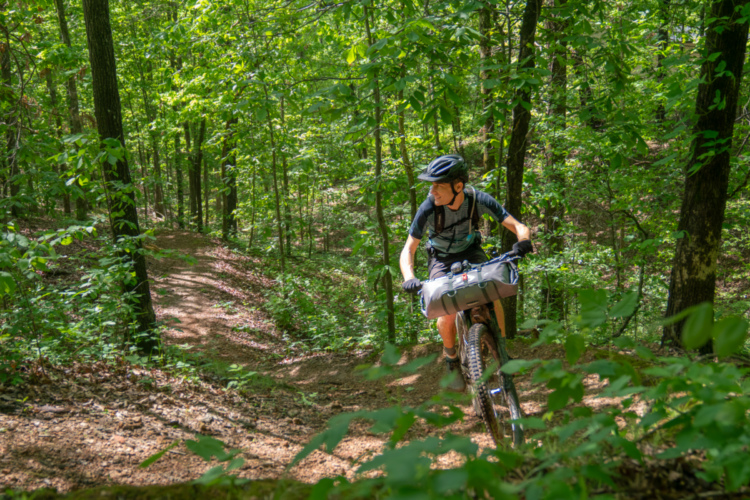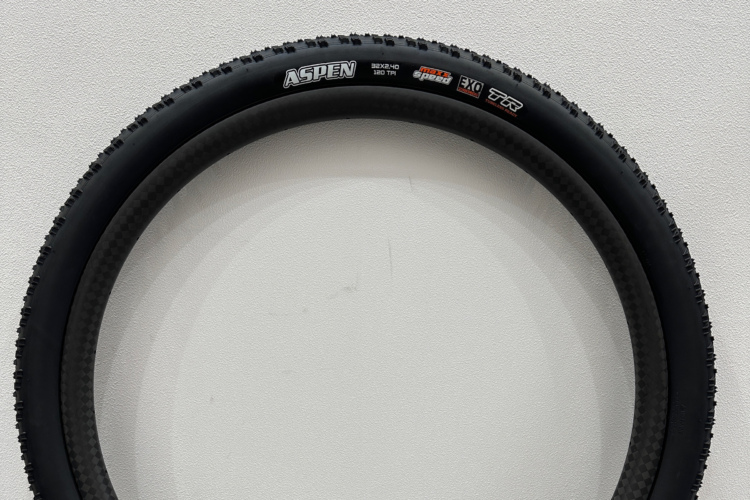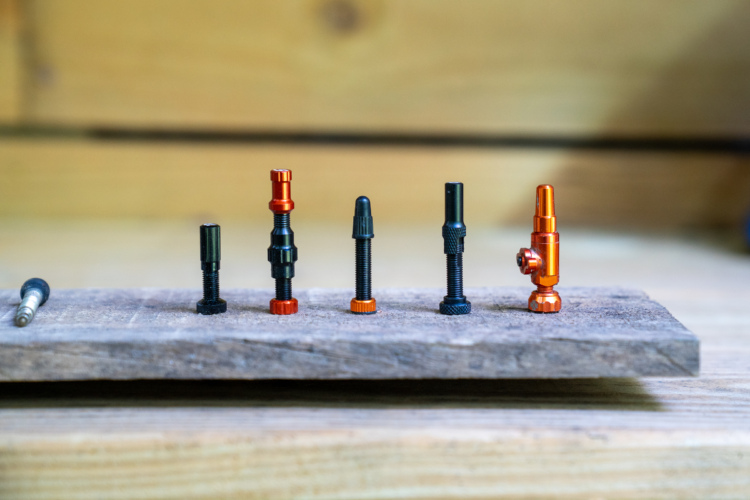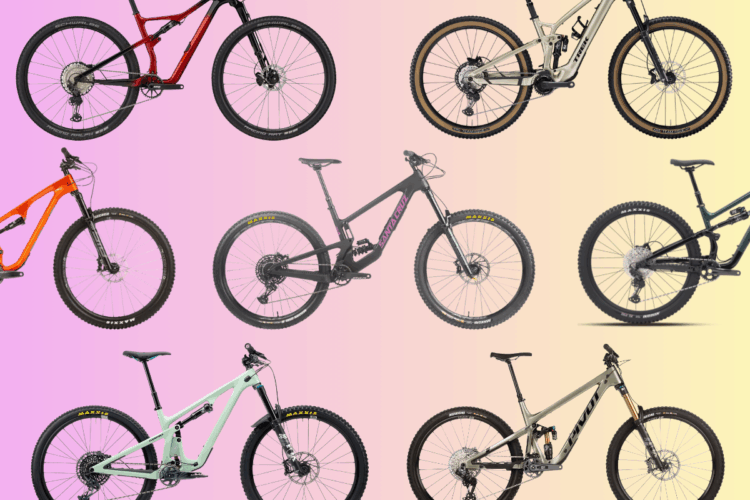
Mountain biking is a full sensory experience, with a barrage of sounds hitting your ears: the rush of the wind on a downhill; the buzz of a freehub while coasting; the quick, aerated puffs of the suspension components working; and tires clamoring for traction over various surfaces. These sounds, along with Nature’s song, make me happy. What drives me absolutely bananas, though, is a noisy bike. I strive to keep my own bikes as squeak and creak free as possible through regular maintenance. And if your bike is making a racket, I’ll do my best to drop your ass so I don’t have to listen to it.
Luckily, many of these noises can be easily resolved at home with a few tools and a little elbow grease. I’ll guide you from the front of your mountain bike to the back, covering common offending areas, and offering ways to muffle them. If I left anything out, or if you have different solutions, please feel free to comment below!
Front Wheel

Issue: Crunching or grinding noise when the wheel is spinning
Likely culprit: Worn out bearings or a dry axle
Remedy: If you have cup and cone bearings, it can be as simple as cleaning the bearings and repacking them with fresh grease. However, most mid- to high-end hubs are going to use sealed cartridge bearings. Swapping these out is going to be more involved – requiring a bearing punch and press. These are specialized tools, and they aren’t cheap. The bearings themselves will only run a few bucks, but you’ll have to cover the cost of labor at your local shop.

A dirty, dry axle can also cause noise. Dirt in between the hub end caps and the fork dropouts is another possibility. Take your front wheel off your bike; thoroughly clean and dry the axle, hub, and fork; apply a thin film of grease on the axle; and reassemble.

Issue: Squeaking noise from disc rotor
Likely culprit: Misaligned caliper or bent rotor
Remedy: Loosen the bolts on your caliper just enough so that the caliper has room to wiggle around. Spin your wheel and gently apply the brake until the wheel stops. While continuing to hold the brake lever, tighten the caliper bolts back down, alternating between the bolts. With the caliper secure, give the wheel another spin. If you’re still hearing some noise, chances are your rotor is bent.

Rotors can get bent for a variety of reasons, but they’re malleable so they can easily be bent back into place. There are rotor truing tools designed expressly for this purpose, but an adjustable crescent wrench will work just fine. Spin your wheel slowly to isolate the location of the noise. Once you find it, use the truing tool or wrench to gently bend the rotor in the opposite direction of the rub. Don’t use pliers with rough teeth as they can damage your rotor. Be gentle and make gradual adjustments – you don’t want to tweak it so far that it rubs on the other side!
If the noise is coming from the rear brake, the process is the same.
Headset

Issue: Clicking or popping noise coming from headtube
Likely culprit: Loose or dirty headset
Remedy: While holding your front brake tightly, turn the bars 90-degrees to either side. Place your free hand on the top of your headset, beneath your stem. Rock the bike forward. If you feel any play here, or hear any noise, your headset is likely loose.
To cover all your bases here, it’s a good idea to remove your stem, drop your fork out of the frame, and take the bearings out of their cups. Clean and dry everything (bearings, cups, and fork steerer), apply a thin film of grease to the exterior of the bearings and cups, and reassemble.
As for the headset, with everything reassembled, and the stem bolts still loose, tighten the top cap down until there is no play left in the headset. This is your bearing preload. Be cautious to not over tighten your top cap as you can damage your bearings and make steering difficult. Realign your handlebars and torque the stem bolts down to spec.
Cockpit

Issue: General creaking/clicking coming from the handlebar area
Likely culprit: Dirt underneath the stem or grips; worn out grips; dirty bolts
Remedy: This is one of the most common noises I have to correct on my own bikes. Dirt, mixed with salty sweat, makes its way into places that can’t be cleaned unless you take some things apart. Pull off your grips and clean the bar underneath, in addition to the insides of the grips. The same goes for the interface between your stem and handlebar. Remove the faceplate, clean it, the bars, and the rest of the stem. Take the opportunity to clean and re-lube your stems bolts at this time, too.
I’ve also had grips that developed a creak or wiggle once they got worn. If tightening down the bolts doesn’t help, it’s probably time to replace them. Be careful not to over tighten the bolts on your grips, particularly on carbon bars.

Issue: Creaking from saddle or seatpost
Likely culprit: Dirt and dry bolts
 Remedy: Your saddle and seatpost take a lot punishment: from your butt, from your sweat, and from the trail. Everything your back tire kicks up is coating your saddle and post. As with a creaking stem or handlebar, it’s often just a matter of disassembling, cleaning, and greasing the offending components. Just be sure to keep your saddle’s rails free of grease as you don’t want those slipping. Also, make note of your saddle position – height, fore/aft position, and tilt – before taking things apart. That way you can get it back in the right spot.
Remedy: Your saddle and seatpost take a lot punishment: from your butt, from your sweat, and from the trail. Everything your back tire kicks up is coating your saddle and post. As with a creaking stem or handlebar, it’s often just a matter of disassembling, cleaning, and greasing the offending components. Just be sure to keep your saddle’s rails free of grease as you don’t want those slipping. Also, make note of your saddle position – height, fore/aft position, and tilt – before taking things apart. That way you can get it back in the right spot.
A post in need of lube can also make noise. It’s a good idea to regularly remove, clean, and lube your post and seat tube even if it’s not creaking. While you can use grease on a straight post (assuming it’s metal), many manufacturers advise against its use on dropper posts. Instead, use a friction paste. This will help prevent the post from slipping, but it has a tendency to wear out faster than conventional grease, so check it more often.
This isn’t too common, but I’ve had the actual rails of a saddle creak where they meet the plastic base. I could get through a couple rides by applying a few drops of chain lube to each of the junctions, but it wasn’t a permanent solution. Unfortunately, the long-term fix is a new saddle. Just don’t buy the same model next time.
Cranks / Bottom Bracket / Pedals

Issue: Creaking, clicking, popping from bottom bracket area while pedaling
Likely culprit: Loose BB, chainring, or crank arm; worn out pedals
Remedy: The BB is a high stress area, taking punishment from pedaling, pumping, jumping, and landing. There’s a lot going on down there. Over time, chainring bolts, crank bolts, lock rings, and even the BB itself can work themselves loose. Sometimes a noise will alert you to the problem, but other times, you can feel play in the cranks.

Except for a few holdouts, most modern mountain bikes are going to use some sort of press fit BB. There are valid reasons for using press fit, but their biggest drawback is in maintenance. Unless you have the tools and knowledge required to work on your bike’s particular press fit BB, I would leave it up to a bike shop. If you’ve tried cleaning, lubing, and even replacing your press fit BB to no avail, check out the TorqTite BB from Enduro Bearings. Think of it as a hybrid BB in which one cup is pressed into the frame and the opposite cup is then threaded into it. There are similar products available from Praxis Works, Wheels Manufacturing, and Hope Tech.
For those fortunate to have a threaded BB, maintenance is much easier. Sometimes all it takes to silence a BB is to snug it back down tightly against the shell. At least once a year you should remove, clean, and regrease your BB and BB shell – more often if you ride through lots of strems or in the rain.
Other spots to check for noise include the chainring bolts or the lock ring found on some direct mount chainrings. I prefer steel chainring bolts over aluminum because they can handle more torque and are less likely to seize.
Some cranks, such as those from Shimano and Race Face, have bearing preload adjustment that can be used to eliminate side-to-side play, which can cause a clicking noise while pedaling. On Shimano cranks, you’ll need to loosen the pinch bolts on the non-drive side crank arm before adjusting the preload. This step isn’t necessary on Race Face’s cranks. The goal is to get the preload tight enough so there’s no slop, while still allowing the cranks to spin freely.
And finally, pedals can be another source of clicking or popping. This typically happens when the bearings or bushings inside the pedal become worn out. In this case, you’ll need to rebuild your pedals. The process for this varies greatly between manufacturers.
Suspension Pivots

Issue: Creaking from pivot areas
Likely culprit: Loose hardware, worn out bearings
Remedy: As with most of the other issues mentioned here, the fix can be as simple as cleaning and lubing. Other times it could be due to loose hardware. However, don’t over torque the bolts as that will damage the bearings and degrade suspension performance.
Certain bikes, like those from Santa Cruz, have easy to use grease ports where maintenance is as simple as a couple pumps from a grease gun. But most bikes are going to use cartridge bearings, which are pressed into the frame or linkage. As with other cartridge bearings, you’ll need a punch to remove them and a press to fit new ones. Replacing bearings can be an involved process depending on the suspension design. Often, the more complex the system, the more bearings involved. The reward for replacing your bearings is quiet and buttery-smooth suspension.
Probably the best thing you can do to keep noise from developing and to prolong the life of your bearings is to keep them clean in the first place. Avoid spraying water at high pressures directly at any of your bike’s bearings. Even a garden hose will flush out your bearing’s vital grease if held close enough. Also, avoid using heavy duty degreasers in these areas.
Drivetrain

Issue: Squeaking, crunchy, grinding noises
Likely culprit: Dirt, lack of lube, misalignment, loose components
Remedy: Your drivetrain necessarily has lots of moving parts. More parts mean more potential problems though, which is why many riders prefer 1x drivetrains or even singlespeed mountain bikes. The number one issue with drivetrains is a squeaky chain. Keep your chain clean and lubed to prevent this. There are a million different lubes out there on the market, many of which are tailored to specific riding conditions, so take your pick. Some of my favorites are the Rock N Roll Gold and Finish Line’s Ceramic.
[see_also id=”198058″][/see_also]


Once your chain is sorted, if your drivetrain is still making noise, there are a few other common issues. Rear derailleur setup is not difficult but it is tedious. There are numerous articles, videos, and tutorials if you need some help. Basically though, you need to make sure your limit screws are set correctly, your shifter cable has proper tension, and that your derailleur hanger is aligned.
Worn out derailleur pulleys can also cause rumbling and shifting issues. Swapping in a fresh set is super easy; there’s just two bolts two remove. Just be sure to order the correct pulleys for your particular derailleur. Certain SRAM rear derailleurs use alternating narrow/wide tooth profiles on their pulleys, similar to their chainrings. If the chain somehow gets mistimed on one of the pulleys – like after taking the wheel off to change a flat – you’ll get a rumbling sound that you can also feel through your pedals. If this happens, stop, pull the derailleur cage forward, lock it in place, and realign the chain correctly.
Other possible drivetrain culprits can include loose cassettes, derailleur bolts, and derailleur hanger bolts.
Issue: Chain slap
Likely culprit: Derailleur clutch not engaged, wrong chain length, exposed chain or seat stays
Remedy: Clutch rear derailleurs, 1x drivetrains, narrow/wide chainrings, and integrated frame protection have all gone a long way towards quieting chain slap. That of course assumes your drivetrain is set up correctly. Should you have a Shimano derailleur, the first thing to do is to make sure your rear derailleur’s clutch is engaged (SRAM’s Type 2 and Type 3 rear derailleurs use a roller bearing clutch that is always engaged). It’s the small switch located near the top pulley. Sometimes the solution is just as simple as flicking that switch into the on position.
If you’re still getting chain slap, make sure your chain is the proper length. If there’s too much slack the derailleur won’t be able to account for all the extra chain, which will lead to it banging around. Here’s a very thorough video from Park Tool on how to determine the proper chain length for a variety of drivetrains:
After ensuring your clutch is engaged and your chain is the proper length, if you’re still getting chain slap, you may need to cover your frame with some sort of protective material to deaden the noise and prevent paint damage. The cheapest way to do this is to use an old inner tube and wrap it around your stays in a similar fashion to applying bar tape on a drop bar bike. Use a little electrical tape at the end to keep it from unraveling. Many manufacturers are integrating rubber protectors into the frame itself, but in some cases they might not be long enough to completely eliminate chain slap.

So there you have it: a ton of ways your bike can make noise, along with some possible remedies. As you can see, a lot of these noises are just due to our bikes getting dirty… which is bound to happen in our sport of mountain biking. A little regular maintenance and the occasional wash can go a long way towards making your bike a silent, singletrack-shredding machine.









1 Comments
Mar 21, 2017
Seriously though, based on this I don't re-grease things often enough. Thanks for the breakdown here!